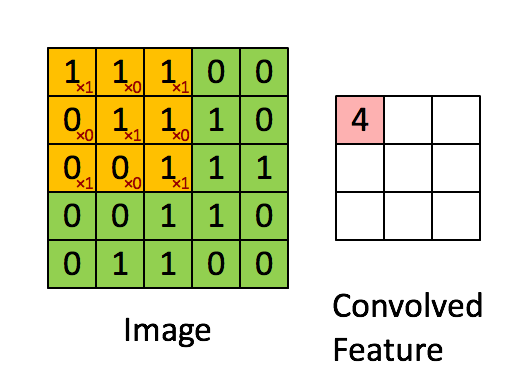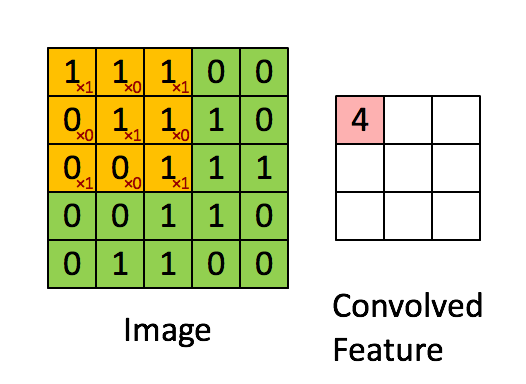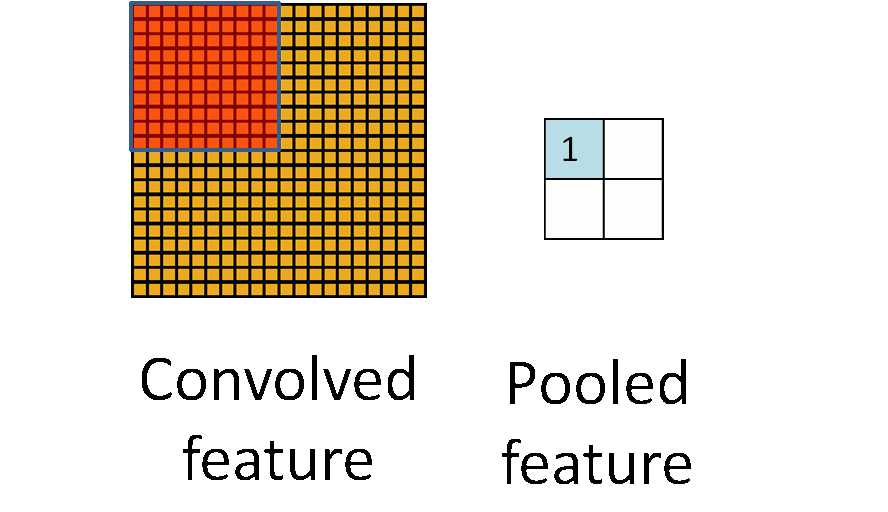本文将介绍如何采用卷积神经网络(CNN)来处理Fashion-MNIST数据集。
程序流程如下:
1、准备样本数据
2、构建卷积神经网络模型
3、网络学习(训练)
4、消费、测试
除了网络模型的构建,其它步骤都和前面介绍的普通神经网络的处理完全一致,本文就不重复介绍了,重点讲一下模型的构建。
先看代码:
/// <summary> /// 构建网络模型 /// </summary> private Model BuildModel() { // 网络参数 float scale = 1.0f / 255; var model = keras.Sequential(new List<ILayer> { keras.layers.Rescaling(scale, input_shape: (img_rows, img_cols, channel)), keras.layers.Conv2D(32, 5, padding: "same", activation: keras.activations.Relu), keras.layers.MaxPooling2D(), keras.layers.Conv2D(64, 3, padding: "same", activation: keras.activations.Relu), keras.layers.MaxPooling2D(), keras.layers.Flatten(), keras.layers.Dense(128, activation: keras.activations.Relu), keras.layers.Dense(num_classes,activation:keras.activations.Softmax) }); return model; }
keras.layers.Conv2D方法创建一个卷积层
keras.layers.MaxPooling2D方法创建一个池化层
卷积层的含义:

如上图所示,原始数据尺寸为5*5,卷积核大小为3*3,当卷积核滑过原始图片时,卷积核和图片对应的数据进行运算(先乘后加),并形成新的数据。
示例的卷积核为[[1,0,1],[0,1,0],[1,0,1]],和左上角数据卷积后结果为4,填写到对应位置。对整改图片全部滑动一遍,即形成最终结果。

采用卷积神经网络,相对于前面介绍的普通神经网络有什么优势呢?
1、首先,图像本身是一个二维数据,普通网络首先要把数据拉平,这一点就不合理,而卷积网络通过卷积核处理数据,保留了原始数据的基本特征;
2、其次,采用卷积网络大大减小了参数的数量。假设原始图片分辨率为100*100,拉平后长度为10000,后面跟一个全连接层,输出为128,此时参数量为(10000+1)*128,超过128万。这才一个全连接层。如果采用CNN,参数数量取决于卷积核的大小和数量。假设卷积核大小为5*5,数量为32,此时参数数量为:(5*5+1)*32=832。【计算方法下面会详细介绍】
池化层的含义:
池化就是压缩,就是图片数据太大了,通过池化把分辨率减小一些。

池化有均值池化和最大值池化方法,这个很好理解,就是一推数据中取平均值或最大值。MaxPooling2D明显是最大池化法。
我们再看一下这个代码:
keras.layers.Conv2D(32, 5, padding: "same", activation: keras.activations.Relu),
32表示卷积核数量为32,卷积核大小为5*5,padding: "same"表示对图像进行边缘补零,不然卷积后的图像尺寸会变小,补零后图像尺寸不变。
整体模型摘要信息如下:

下面逐行解释一下:
1、首先输入层的数据Shape为:(28,28,1),28表示图片像素,1表示灰度图片,如果是彩色图片,应该为(28,28,3)
2、Rescaling对数据进行处理,统一乘以一个系数,这里没有需要训练的参数
3、引入一个卷积层,卷积核数量为32,卷积核大小为5*5(图上看不出来),此时参数数量为:(5*5+1)*32=832,这里卷积核尺寸为5*5,所以有25个参数,这很好理解,+1是因为作为卷积计算后还要加一个偏置b,所以每个卷积核共26个参数。由于有32个卷积核,要对同一个图像采用不同的卷积核做32次计算,所以这一层输出数据为(28,28,32)
4、池化层将数据从(28,28,32)压缩到(14,14,32)
5、再引入一个卷积层,卷积核数量为64,卷积核大小为3*3(图上看不出来),这次计算和第一次不太一样:由于上一层数据共有32片,对每一片数据采用的卷积核是不一样的,所以这里实际一共有32*9=288个卷积核。首先用32个卷积核和上述32片数据分别进行卷积形成32片数据,然后将32片数据叠加求和,最后再加一个偏置形成一片新数据,重复进行64次,形成64片新数据。此时参数数量为:(288+1)*64=18496
【注意:这里的算法其实是和第一层卷积算法完全一样的,只是第一层输入为灰度图片,数据只有一片,如果输入为彩色图片,就一致了。】
6、池化层将数据从(14,14,64)压缩到(7,7,64)
7、将数据拉平,拉平后的数据长度为:7*7*64=3136
8、引入全连接层,输出神经元数量为128,此时参数数量为:(3136+1)*128=401536
9、最后为全连接层输出,输出神经元数量为10,参数数量为:(128+1)*10=1290
现在,由于参数数量已经很多了,训练需要的时间也比较长了,所以需要把训练完成后的参数保存下来,下次可以重新加载保存的参数接着训练,不用从头再来。
保存的模型也可以发布到生产系统用于实际的消费。
全部代码如下:

/// <summary> /// 采用卷积神经网络处理Fashion-MNIST数据集 /// </summary> public class CNN_Fashion_MNIST { private readonly string TrainImagePath = @"D:\Study\Blogs\TF_Net\Asset\fashion_mnist_png\train"; private readonly string TestImagePath = @"D:\Study\Blogs\TF_Net\Asset\fashion_mnist_png\test"; private readonly string train_date_path = @"D:\Study\Blogs\TF_Net\Asset\fashion_mnist_png\cnn_train_data.bin"; private readonly string train_label_path = @"D:\Study\Blogs\TF_Net\Asset\fashion_mnist_png\cnn_train_label.bin"; private readonly string ModelFile = @"D:\Study\Blogs\TF_Net\Model\cnn_fashion_mnist.h5"; private readonly int img_rows = 28; private readonly int img_cols = 28; private readonly int channel = 1; private readonly int num_classes = 10; // total classes public void Run() { var model = BuildModel(); model.summary(); model.load_weights(ModelFile); Console.WriteLine("press any key"); Console.ReadKey(); model.compile(optimizer: keras.optimizers.Adam(0.0001f), loss: keras.losses.SparseCategoricalCrossentropy(), metrics: new[] { "accuracy" }); (NDArray train_x, NDArray train_y) = LoadTrainingData(); model.fit(train_x, train_y, batch_size: 512, epochs: 1); model.save_weights(ModelFile); test(model); } /// <summary> /// 构建网络模型 /// </summary> private Model BuildModel() { // 网络参数 float scale = 1.0f / 255; var model = keras.Sequential(new List<ILayer> { keras.layers.Rescaling(scale, input_shape: (img_rows, img_cols, channel)), keras.layers.Conv2D(32, 5, padding: "same", activation: keras.activations.Relu), keras.layers.MaxPooling2D(), keras.layers.Conv2D(64, 3, padding: "same", activation: keras.activations.Relu), keras.layers.MaxPooling2D(), keras.layers.Flatten(), keras.layers.Dense(128, activation: keras.activations.Relu), keras.layers.Dense(num_classes,activation:keras.activations.Softmax) }); return model; } /// <summary> /// 加载训练数据 /// </summary> /// <param name="total_size"></param> private (NDArray, NDArray) LoadTrainingData() { try { Console.WriteLine("Load data"); IFormatter serializer = new BinaryFormatter(); FileStream loadFile = new FileStream(train_date_path, FileMode.Open, FileAccess.Read); float[,,,] arrx = serializer.Deserialize(loadFile) as float[,,,]; loadFile = new FileStream(train_label_path, FileMode.Open, FileAccess.Read); int[] arry = serializer.Deserialize(loadFile) as int[]; Console.WriteLine("Load data success"); return (np.array(arrx), np.array(arry)); } catch (Exception ex) { Console.WriteLine($"Load data Exception:{ex.Message}"); return LoadRawData(); } } private (NDArray, NDArray) LoadRawData() { Console.WriteLine("LoadRawData"); int total_size = 60000; float[,,,] arrx = new float[total_size, img_rows, img_cols, channel]; int[] arry = new int[total_size]; int count = 0; DirectoryInfo RootDir = new DirectoryInfo(TrainImagePath); foreach (var Dir in RootDir.GetDirectories()) { foreach (var file in Dir.GetFiles("*.png")) { Bitmap bmp = (Bitmap)Image.FromFile(file.FullName); if (bmp.Width != img_cols || bmp.Height != img_rows) { continue; } for (int row = 0; row < img_rows; row++) for (int col = 0; col < img_cols; col++) { var pixel = bmp.GetPixel(col, row); int val = (pixel.R + pixel.G + pixel.B) / 3; arrx[count, row, col, 0] = val; arry[count] = int.Parse(Dir.Name); } count++; } Console.WriteLine($"Load image data count={count}"); } Console.WriteLine("LoadRawData finished"); //Save Data Console.WriteLine("Save data"); IFormatter serializer = new BinaryFormatter(); //开始序列化 FileStream saveFile = new FileStream(train_date_path, FileMode.Create, FileAccess.Write); serializer.Serialize(saveFile, arrx); saveFile.Close(); saveFile = new FileStream(train_label_path, FileMode.Create, FileAccess.Write); serializer.Serialize(saveFile, arry); saveFile.Close(); Console.WriteLine("Save data finished"); return (np.array(arrx), np.array(arry)); } /// <summary> /// 消费模型 /// </summary> private void test(Model model) { Random rand = new Random(1); DirectoryInfo TestDir = new DirectoryInfo(TestImagePath); foreach (var ChildDir in TestDir.GetDirectories()) { Console.WriteLine($"Folder:【{ChildDir.Name}】"); var Files = ChildDir.GetFiles("*.png"); for (int i = 0; i < 10; i++) { int index = rand.Next(1000); var image = Files[index]; var x = LoadImage(image.FullName); var pred_y = model.Apply(x); var result = argmax(pred_y[0].numpy()); Console.WriteLine($"FileName:{image.Name}\tPred:{result}"); } } } private NDArray LoadImage(string filename) { float[,,,] arrx = new float[1, img_rows, img_cols, channel]; Bitmap bmp = (Bitmap)Image.FromFile(filename); for (int row = 0; row < img_rows; row++) for (int col = 0; col < img_cols; col++) { var pixel = bmp.GetPixel(col, row); int val = (pixel.R + pixel.G + pixel.B) / 3; arrx[0, row, col, 0] = val; } return np.array(arrx); } private int argmax(NDArray array) { var arr = array.reshape(-1); float max = 0; for (int i = 0; i < 10; i++) { if (arr[i] > max) { max = arr[i]; } } for (int i = 0; i < 10; i++) { if (arr[i] == max) { return i; } } return 0; } }
通过采用CNN的方法,我们可以把Fashion-MNIST识别率提高到大约94%左右,而且还有提高的空间。但是网络的优化是一件非常困难的事情,特别是识别率已经很高的时候,想提高1个百分点都是很不容易的。
以下是一个优化过的网络,我查阅了不少资料,也参考了很多代码,才构建了这个网络,它的识别率约为96%,再怎么调整也提高不上去了。
/// <summary> /// 构建网络模型 /// </summary> private Model BuildModel() { // 网络参数 float scale = 1.0f / 255; var model = keras.Sequential(new List<ILayer> { keras.layers.Rescaling(scale, input_shape: (img_rows, img_cols, channel)), keras.layers.Conv2D(32, 3, padding: "same", activation: keras.activations.Relu), keras.layers.MaxPooling2D(), keras.layers.Conv2D(64, 3, padding: "same", activation: keras.activations.Relu), keras.layers.MaxPooling2D(), keras.layers.Dropout(0.3f), keras.layers.BatchNormalization(), keras.layers.Conv2D(128, 3, padding: "same", activation: keras.activations.Relu), keras.layers.Conv2D(128, 3, padding: "same", activation: keras.activations.Relu), keras.layers.MaxPooling2D(), keras.layers.Dropout(0.4f), keras.layers.Flatten(), keras.layers.Dense(512, activation: keras.activations.Relu), keras.layers.Dropout(0.25f), keras.layers.Dense(num_classes,activation:keras.activations.Softmax) }); return model; }
【参考资料】
卷积神经网络CNN总结 - Madcola - 博客园 (cnblogs.com)
卷积神经网络(CNN)模型结构 - 刘建平Pinard - 博客园 (cnblogs.com)
【相关资源】
源码:Git: https://gitee.com/seabluescn/tf_not.git
项目名称:CNN_Fashion_MNIST,CNN_Fashion_MNIST_Plus
